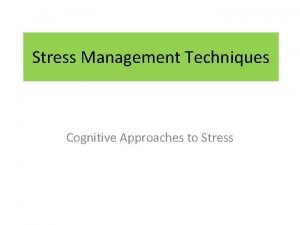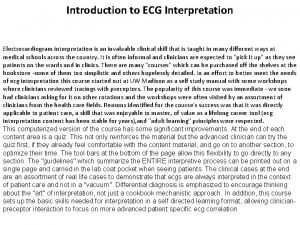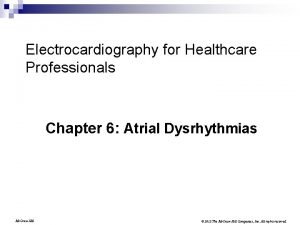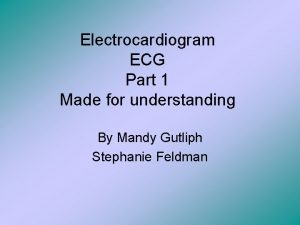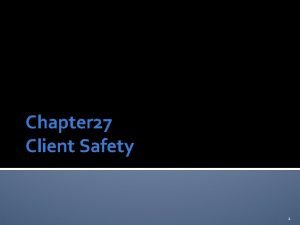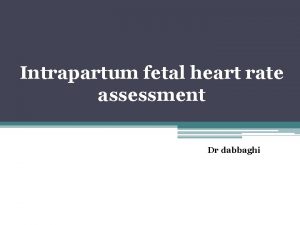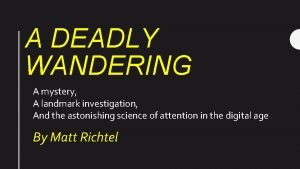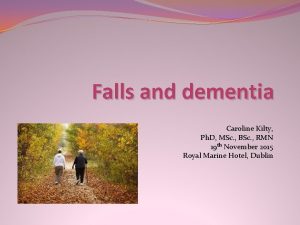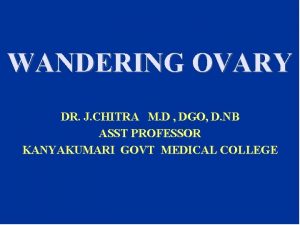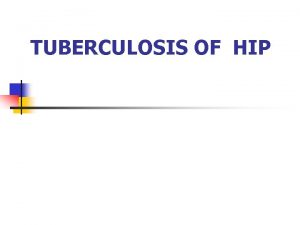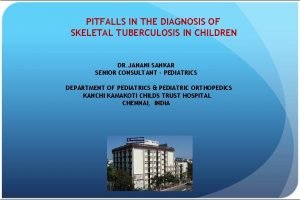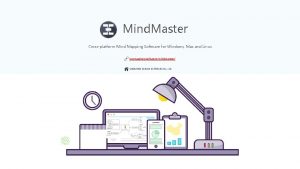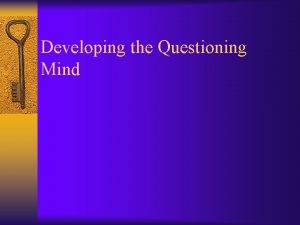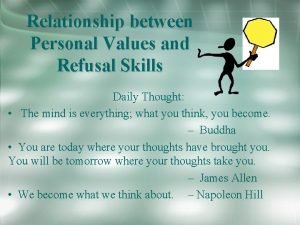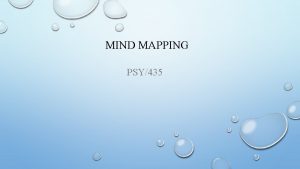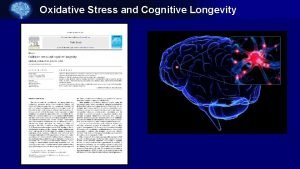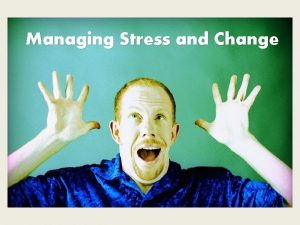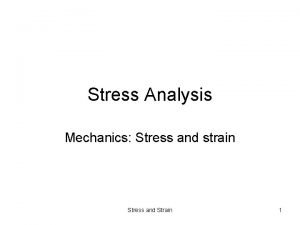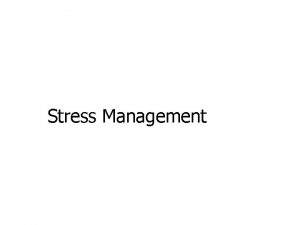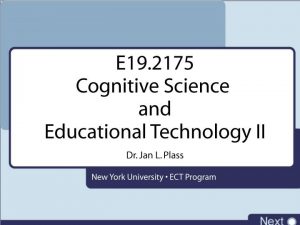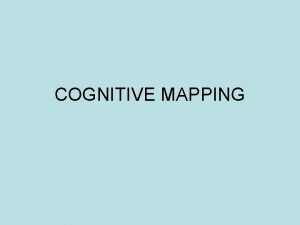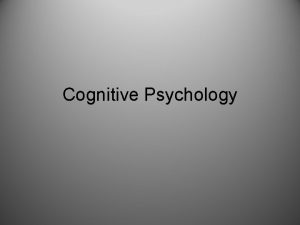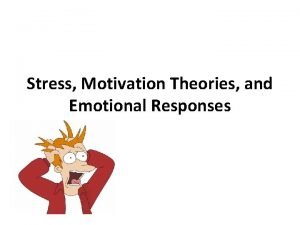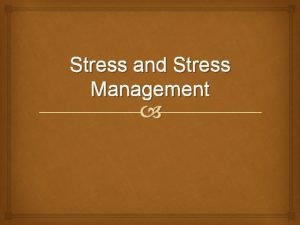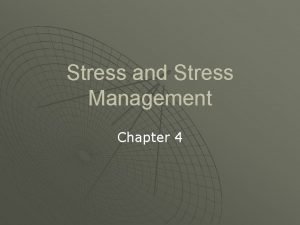Stress Cognitive Control and The Wandering Mind Can

































































- Slides: 65

Stress, Cognitive Control, and The Wandering Mind: Can Mindfulness Help? DR. JONATHAN BANKS

What is stress? Events in the environment? An internal state?

Stress What are some things that stress you out?



Two Stress Pathways 1) Hypothalamus – Adrenal Medulla (SAM) First response (epinephrine) 2) Hypothalamus – Pituitary – Adrenal Cortex (HPA) Secondary response Cortisol imummosuppressor

Stress and Health Males: Fight or Flight Syndrome Hypothalamus releases cortico-steroids Blood vessels, muscles, and brain constrict Sweat, heart rate, breathing increase

Stress and Health Females: Tend and Befriend Ensure safety of offspring by tending to their needs Befriend others to help protect offspring

Cortisol • Increases blood sugar • Breaks down protein and fats • In severe stress, increases 10 x • Anti-inflammatory • Immunosuppresive

What about the impact on Cognitive performance? Attention Working memory Applied: Exams

Evolutionary Perspective

Hurt or Help Should stress hurt or help cognitive performance? It depends On the cognitive function

What should be helped by stress? Anything that helps running from a predator Only for Acute not chronic stress

What is hurt? Everything else-- Decision Making (Baradell & Klein, 1993) Problem Solving (Klein & Barnes, 1994) Working Memory (Klein & Boals, 2001 a; Sliwinski, Smyth, Hofer, & Stawski, 2006) Everyday Cognitive Failures (Boals & Banks, 2012) Executive Functioning (Eysenck et al. , 2007) Shifting Inhibition Updating

The working memory system Rehearsal is coordinated by the central executive. “A multi-purpose processor capable of running many different operations on many different types of material” Tied closely to attention – attending to something involves its’ incorporation into working memory The executive deals with response selection, planning, goal setting It also initiates the rehearsal loops 15

Figure 4. 1 A schematic representation of Baddeley's Working Memory. The phonological loop is made up of the articulatory control process and the phonological store, and the corresponding process and store for visuo-spatial information are the visuo-spatial sketchpad and the visual scribe. Source: Based on descriptions from Baddeley (2000) and Baddeley & Logie (1999).

Executive Attention Model of Working Memory (Kane, Conway, Hambrick, & Engle, 2007) Working memory is responsible for the control of executive attention. Thus predicts inhibitory control (Engle, 2004): Stroop (Kane & Engle, 2003) Antisaccade (Unsworth, Schrock, & Engle, 2004) Fluid Intellegence (Engle & Kane, 2004) Mind wandering (Mc. Vay & Kane, 2009) Task Unrelated Thoughts

Why does stress impair these functions? Depends on the type of stress? Physical vs Psychological Acute vs Chronic

Psychological Mind wandering (Task-unrelated thoughts-TUTs) 50% of our daily life (Killingsworth& Gilbert, 2010) Wegner (1994)- Ironic Process




Working Memory and Mind Wandering Control of Executive Attention (Kane, Conway, Hambrick, & Engle, 2007) Control over Mind Wandering (Mc. Vay & Kane, 2010) But…Mind Wandering impairs performance (Randall, Oswald, & Beier, 2014) Working Memory Mind Wandering

Mind Wandering - Working Memory + Cognitive Task Performance (SUSTAINED ATTENTION)

Banks, Tartar, & Tamayo, 2015 We were interested understanding the role of mind wandering, or Task Unrelated Thoughts (TUTs), and cortisol in stress related working memory impairments. Psychological stress manipulation We hypothesized that at baseline the percentage of TUTs would mediate the relationship between State Anxiety and WM Negative life event Cortisol should moderate the impact of TUTs on WM Additionally, the stress manipulation would increase percentage of TUTs and subsequently decrease AOSPAN performance.

Methods 60 undergraduates (43 women, M age = 21. 07, SD= 3. 30) from Nova Southeastern University Baseline Measures (Time 1) AOSPAN (w/ Thought Probes) STAI-ST Saliva Sample Post writing measures Stress Writing Task Negative event or Control AOSPAN (w/ Thought Probes) STAI-ST Saliva Sample “During today’s session, I want you to let go and write about your deepest thoughts and feelings about the negative event you nominated. In your writing, you might want to explore your emotions and thoughts about the negative event. ”

Thought Probes (a) task-related thoughts, exclusively, (b) task performance/evaluative thoughts (positive) (c) task performance/evaluative thoughts (negative) (d) everyday stuff (e) current state of being (f) daydreams (g) other TUTs

Stress Manipulation • No effect of time, condition, or time by condition interaction on AOSPAN task performance, p >. 05 • Significant time x condition interaction on state anxiety, F(1, 56)= 4. 19, p <. 05, partial η 2 =. 07, with a greater increase in the stress condition, t(56) = 2. 05, p <. 05, d = 0. 36.

Change in TUTs Significant increase in TUTs over time, F(1, 56) = 8. 77, p <. 01, partial η 2 =. 16, but the effect is driven by increases in the stress condition, t(27) = 2. 70, p <. 05, d = 0. 55.

Does Mind Wandering Mediate the Relationship between State Anxiety and WM? TUTs -28. 81* 0. 006* AOSPAN State Anxiety c= -. 37, c’ = -. 20 A mediation analyses revealed a significant indirect effect of State Anxiety on AOSPAN task performance that is mediated by TUT percentage, Indirect effect = -. 17, Bootstrapped SE =. 11, Bootstrapped 95% CI [-. 50, -. 03] Note: Values represent unstandardized path coefficients, * p <. 05

Does Cortisol Moderate the Impact of TUTs on WM? TUTs have a negative impact on AOSPAN performance at mean levels of cortisol, b = -25. 64, SE = 10. 86, p <. 05, 95% CI [-47. 41, -3. 86], and at higher levels of cortisol, b = -51. 54, SE = 14. 12, p <. 001, 95% CI [-79. 85, -23. 24].

Impact of Baseline AOSPAN Performance on TUTs at Time 2 by Condition In the control condition, baseline AOSPAN task performance scores predicted TUTs, β =. 43, t(1) = 2. 33, p <. 05, but not in the stress condition.

Banks & Boals, 2016 • • Examined the impact of a positive, negative, or neutral writing manipulation on mind wandering and working memory Participants wrote about a future event Also, examined the role of daily stressors on working memory and mind wandering Hypotheses: Writing about a future negative, but not positive or neutral event, will result in increases in TUTs and decreases in WM task performance. TUTs will mediate the relationship between life stress and WM task performance

150 undergraduates (84 females; M age = 21. 28 years) at the University of North Texas (50 per condition). N = 126 Session 2 (Positive event condition n = 41; Negative event condition n = 45); Control event condition n = 40) Session 2 Session 1 Baseline Measures AOSPAN and RSPAN (With Thought Probe) Daily Inventory of Stressful Events White Bear Suppression Inventory Writing Task Future Negative Future Positive Control Post writing measures AOSPAN and RSPAN (With Thought Probe) Daily Inventory of Stressful Events Life Experiences Scale Impact of Events Scale

Thought Probes (a) Task-related thought, exclusively, (b) Task performance/evaluative thoughts, (c) Task-unrelated, neutral content, (d) Task-unrelated, positive content, (e) Task-unrelated, negative content. (f) Task-unrelated, about the event I wrote about. (Time 2 only)

Effect of Writing Manipulation • No effects of condition, time, or time by condition interactions were found for the WM composite score, all p’s >. 05. • A significant effect of time was found on the TUT composite, F (1, 123) = 24. 66, p <. 0001, partial η 2 = 0. 16, such that TUTs increased from Time 1 (M = 0. 00, SD = 0. 84) to Time 2 (M = 0. 37, SD = 0. 98).

Does Mind Wandering Mediate the Relationship between WM at Time 1 and Time 2? TUTs T 2 -0. 14* -0. 43**** Working Memory Composite T 1 C’ 0. 79****(C 0. 83****) Working Memory Composite T 2 Indirect effect = 0. 06, bootstrapped SE = 0. 02, bootstrapped 95% CI [0. 2, 0. 14].

Does Mind Wandering Mediate the Relationship between Stress and WM? TUTs T 1 -0. 64**** 0. 08* DISE T 1 C’ 0. 04 (C -. 01) Working Memory Composite T 1 Indirect effect = -0. 05, bootstrapped 95% CI [-. 11, -0. 01], Kappa =. 11. Note. Values represent unstandardized path coefficients. p <. 05*, p<. 0001****, N =150

So what do we know? Stress stinks…… Stress impairs Working Memory Task Performance Due to increases in Mind Wandering Levels of Cortisol alter the impact of Mind Wandering on Task performance Probably an indirect marker for how physiologically stressed someone is.

Can we fix it?

Canines?

Banks, Mc. Coy, & Trzcinski (In press) We examined the impact of interacting with therapy dogs for 10 minutes on stress and sustained attention in college students. 56 Undergraduates from Nova Southeastern University (n =29 Canine Interaction Condition; n =27 Control Condition) Participants completed measures of Self report stress (Perceived Stress Scale and State Anxiety Inventory), Sustained Attention (SART) Mind Wandering We hypothesized that participants that interacted with the dogs would have lower levels of stress and mind wandering and higher levels of sustained attention than the control participants.

Results There was no significant effect of canine interaction on mind wandering or sustained attention. BUT………

Condition was a significant predictor of both perceived stress (Adj. R 2 =. 117, F(2, 51)= 4. 53, p =. 015, β = -. 27) and State Anxiety (Adj. R 2 =. 107, F(2, 48)= 3. 98, p =. 025, β = -. 32). Note: error bars represent standard error of the mean

So…. WE NEED MORE DOGS! But what about the cognitive changes? ?

Mindfulness What is mindfulness? Improve awareness through increases in focused attention and through open monitoring of sensations without reactivity to the sensations or thoughts (Davidson & Goleman, 1977).

Impact on Cognition Improve working memory and sustained attention in pre-deployment military cohorts (Jha, Morrison, Parker, & Stanley, 2016; Jha, Stanley, Kiyonaga, Wong, & Gelfand, 2010) Greater engagement in mindfulness practice leads to improved sustained attention in athletes ( Rooks, Morrison, Goolsarran, Rogers, & Jha, 2017).

Mindfulness Banks, Welhaf, & Srour, 2015 We were interested in examining the impact of a brief mindfulness training on working memory, mind wandering, and protection from a stressor Participants completed either a one week at home mindfulness training or relaxation training. We hypothesized that participants would demonstrate increase in WM task performance decrease in mind wandering reduced susceptibility to a stress manipulation. 80 Undergraduates from Nova Southeastern University (n =40 Mindfulness Condition; n =40 Relaxation Control Condition) Session 2 N = 62 (n = 34 Mindfulness condition; n = 28 Relaxation condition)

Session One Baseline Measures (Time 1) AAQ, PANAS, AOSPAN w/ Thought Probes Mindfulness Meditation Training or Relaxation Training AOSPAN w/ Thought Probes (Time 2) Session Two Mindfulness or Relaxation recording AAQ, PANAS, AOSPAN w/ Thought Probes (Time 3) Psychological Stressor AOSPAN w/ Thought Probes (10 minutes) (Time 4), PANAS

Changes in AAQ Decreases in AAQ scores were observed in the MMT condition, t (34) = 3. 94, p <. 001, d =. 40, 95% CI [1. 12, 3. 51] but not RT condition, t (27) = 0. 63, p >. 05, d =. 008, 95% CI [1. 12, 2. 12].

Did Mindfulness Alter WM? An effect of time, F (1, 60) = 6. 53, p <. 05, partial η 2 =. 34, condition, F (1, 60) = 6. 72, p <. 05, partial η 2 =. 11, and time by condition interaction, F (1, 60) = 6. 53, p <. 05, partial η 2 =. 34.

Did Mindfulness alter Mind Wandering? No significant change from Time 1 to Time 3, p >. 05. A trend for an effect of time (Time 3 - Time 4) on TUTs, F (1, 60) = 3. 34, p =. 07, partial η 2 =. 06

So Why Does Mindfulness Help? It appears to alter the impact of mind wandering on task performance. But is all Mind Wandering the same? Mind Wandering Task Performance

Emotional Valence of Mind wandering Most work has assumed that all types of TUTs impact task performance similarly. Look at overall percentage of TUTs We hypothesized that negative not positive TUTs would hurt performance Greater capture of attention for negative vs. positive stimuli (Peeters & Czapinski, 1990) Disengagement (Compton, 2010) Thought suppression (Wegner, 1994) Individuals attempt to suppress negative thoughts (Petrie, Booth, & Pennebaker, 1998; Smart & Wegner, 1999) Suppression (Klein consumes resources & Bratton, 2007)


Banks, Welhaf, Hood, Boals, & Tartar (2016) Reanalyzed data from three prior studies: Banks & Boals (2016) (N = 150) AOSPAN and RSPAN Banks, Tartar, & Welhaf (2014) (N = 53) SART Banks, Welhaf, & Srour (2015) (N = 80) AOSPAN All measures reported in study collected at baseline

Thought probes used in all three studies Please click on the button to indicate what you were just thinking about: a. ) Task-related thoughts, that is, pertaining to the current task b. ) Task-related evaluative thoughts – positive c. ) Task-related evaluative thoughts – negative d. ) Task-unrelated thoughts – neutral content e. ) Task-unrelated thoughts – positive content f. ) Task-unrelated thoughts – negative content

Results: Impact of TUT valence on WM performance Banks, Welhaf, & Srour (2015) Overall percentage of neutral TUTs served as the only significant predictor of AOSPAN performance, β = -0. 24, t = -2. 05, p <. 05. Banks & Boals (2016) Overall percentage of neutral, β = -0. 34, t = -4. 94, p <. 05, and negative TUTs, β = -0. 46, t = -6. 82, p <. 05 served as significant predictors of AOSPAN & RSPAN performance. Overall model, F (3, 75) = 3. 06, p = 0. 033, Adjusted R 2 = 0. 07. Overall model, F (3, 143)= 24. 74, p < 0. 0001, Adjusted R 2 = 0. 33. Banks, Tartar, & Welhaf (2014) NOGO accuracy predicted by RT, β = 0. 52, t = 4. 32, p <. 05 & negative TUTs, β = -0. 27, t = -2. 10, p <. 05 Overall model, F (4, 44) = 8. 47, p < 0. 0001

Don’t worry be Happy

Mindfulness and Mind Wandering We were interested in determining if a brief (15 -minute) mindfulness meditation induction altered the impact of Negative TUTs on Sustained Attention Task performance. 89 Undergraduate from Nova Southeastern University (n =31 Mindfulness Condition; n =27 Relaxation Control Condition; n= 31 Waitlist control) Working Memory Tasks Mindfulness/ Relaxation/ Nothing Stress Manipulation SART (with Thought Probes)

Results No difference between groups on SART accuracy, F (2, 84) = 0. 06, p =. 944. Trend for a difference between groups on percentage of Negative TUTs, F (2, 86) = 2. 92, p =. 059. *p <. 05, +p =. 15

Do Negative TUTs Hurt? Negative TUTs predict poorer SART performance in the Relaxation condition (β= -. 61, p=. 008), Approach significance in the Control condition (β= -. 36, p=. 059) But not the mindfulness condition (β= -. 29, p=. 13)

How does Mindfulness help? It appears that Mindfulness may alter the impact of Negative off task thoughts so that task performance is not harmed.

Thank you to my team of undergraduate and graduate students: Matthew Welhaf Audrey Hood PJ Branceleone Lindsay Craig, Haley Hickey, Eddie Zacka, Amanda Holtzman, Danica Buse, Alyssa Boltson, Brianna Thompson, Alyssa Garcia, Heather Barkman, Chethani Chitraacharige, Lauren Gispert, Yuri Castro Flach, Samantha Rodriguez

Thank you! “Be Mindful of your thoughts, Anakin. They Betray you. ” - Obi-Wan Kenobi
 Wandering mind is an unhappy mind
Wandering mind is an unhappy mind Cognitive and non cognitive religious language
Cognitive and non cognitive religious language True strain equation
True strain equation Chapter 10 stress responses and stress management
Chapter 10 stress responses and stress management Rational vs logical
Rational vs logical 5 states of mind cognitive coaching
5 states of mind cognitive coaching Normal axial stress
Normal axial stress Wandering atrial pacemaker
Wandering atrial pacemaker Wandering atrial pacemaker
Wandering atrial pacemaker Wandering pacemaker
Wandering pacemaker A newly admitted patient was found wandering
A newly admitted patient was found wandering Nomads are wandering people
Nomads are wandering people Absent variability
Absent variability A deadly wandering chapter summary
A deadly wandering chapter summary Dewing wandering risk assessment tool
Dewing wandering risk assessment tool Wandering ovary
Wandering ovary Wandering acetabulum
Wandering acetabulum Wandering acetabulum
Wandering acetabulum Quotes about measurement
Quotes about measurement If you can't measure it you cannot improve it
If you can't measure it you cannot improve it Master mind map
Master mind map The critical mind is a questioning mind
The critical mind is a questioning mind Why are refusal skills important
Why are refusal skills important Hát kết hợp bộ gõ cơ thể
Hát kết hợp bộ gõ cơ thể Ng-html
Ng-html Bổ thể
Bổ thể Tỉ lệ cơ thể trẻ em
Tỉ lệ cơ thể trẻ em Voi kéo gỗ như thế nào
Voi kéo gỗ như thế nào Thang điểm glasgow
Thang điểm glasgow Chúa sống lại
Chúa sống lại Các môn thể thao bắt đầu bằng tiếng đua
Các môn thể thao bắt đầu bằng tiếng đua Thế nào là hệ số cao nhất
Thế nào là hệ số cao nhất Các châu lục và đại dương trên thế giới
Các châu lục và đại dương trên thế giới Công thức tính thế năng
Công thức tính thế năng Trời xanh đây là của chúng ta thể thơ
Trời xanh đây là của chúng ta thể thơ Cách giải mật thư tọa độ
Cách giải mật thư tọa độ Làm thế nào để 102-1=99
Làm thế nào để 102-1=99 Phản ứng thế ankan
Phản ứng thế ankan Các châu lục và đại dương trên thế giới
Các châu lục và đại dương trên thế giới Thể thơ truyền thống
Thể thơ truyền thống Quá trình desamine hóa có thể tạo ra
Quá trình desamine hóa có thể tạo ra Một số thể thơ truyền thống
Một số thể thơ truyền thống Cái miệng bé xinh thế chỉ nói điều hay thôi
Cái miệng bé xinh thế chỉ nói điều hay thôi Vẽ hình chiếu vuông góc của vật thể sau
Vẽ hình chiếu vuông góc của vật thể sau Biện pháp chống mỏi cơ
Biện pháp chống mỏi cơ đặc điểm cơ thể của người tối cổ
đặc điểm cơ thể của người tối cổ Ví dụ về giọng cùng tên
Ví dụ về giọng cùng tên Vẽ hình chiếu đứng bằng cạnh của vật thể
Vẽ hình chiếu đứng bằng cạnh của vật thể Phối cảnh
Phối cảnh Thẻ vin
Thẻ vin đại từ thay thế
đại từ thay thế điện thế nghỉ
điện thế nghỉ Tư thế ngồi viết
Tư thế ngồi viết Diễn thế sinh thái là
Diễn thế sinh thái là Dot
Dot Các số nguyên tố
Các số nguyên tố Tư thế ngồi viết
Tư thế ngồi viết Lời thề hippocrates
Lời thề hippocrates Thiếu nhi thế giới liên hoan
Thiếu nhi thế giới liên hoan ưu thế lai là gì
ưu thế lai là gì Sự nuôi và dạy con của hổ
Sự nuôi và dạy con của hổ Khi nào hổ mẹ dạy hổ con săn mồi
Khi nào hổ mẹ dạy hổ con săn mồi Hệ hô hấp
Hệ hô hấp Từ ngữ thể hiện lòng nhân hậu
Từ ngữ thể hiện lòng nhân hậu Thế nào là mạng điện lắp đặt kiểu nổi
Thế nào là mạng điện lắp đặt kiểu nổi Product control
Product control




